Waterproof binoculars are commonly used for fishing, hunting, hiking, and sightseeing. A marine environment is probably the most extreme conditions for binoculars. When hunting and hiking it can be difficult to keep binoculars dry so having waterproof and fog proof binoculars is also important.
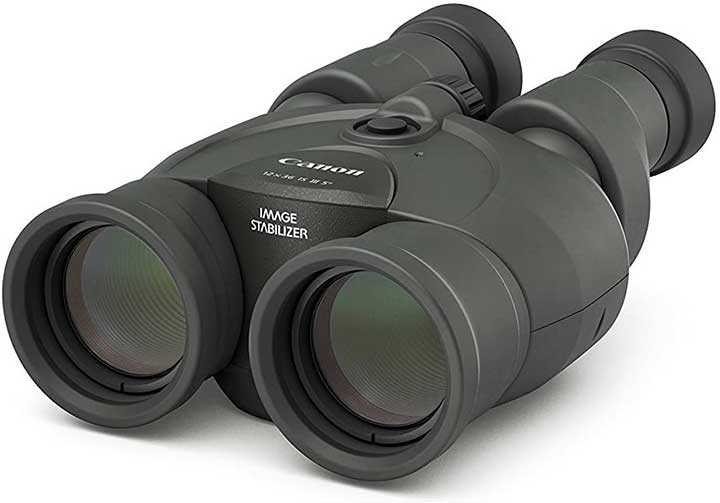
In this article, the best waterproof binoculars will be discussed in detail including image-stabilized waterproof binoculars. When fishing offshore it is common to use binoculars to find frigate birds when fishing for mahi-mahi and tuna birds when fishing for tuna. Having a powerful radar to see birds is ideal but having binoculars helps scan much more area than is possible with your unmagnified eyes.
The ability to stabilize the image when looking through the binoculars needs to be balanced with the magnification. Typically, marine binoculars used for fishing are only 7 or 8 times magnification because the waves rocking the boat make it difficult to hold them steady. If the binoculars are image-stabilized, then a higher power magnification can still allow for a clear picture.
The objective lens diameter is also important to consider. A large 50 mm objective lens lets in lots of light but makes the binoculars larger and heavier. If the binoculars are only going to be used in bright conditions then a smaller objective lens can be used without seeing any real difference in performance. However, when binoculars are stronger than 8 power a 42 mm or larger objective lens is better even for daytime use. The human pupil is around 3 mm in low light and 7 mm in bright conditions. For optimal brightness, the optics exit pupil diameter will be as large as the human pupil.
Here Are the Best Fishing Binoculars
1. Bushnell H2O (Best Value)
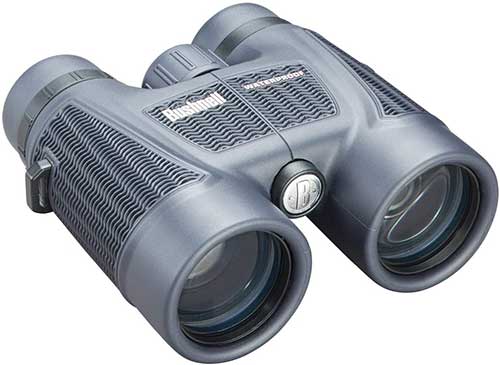
| Estimated Price | $103 |
| Lens | 8×42 |
| Weight | 1.56 lbs, 25 oz |
| FOV (Degrees) | 7.8 |
| FOV at 1000 m | 136 m |
| Waterproof Rating | Waterproof, Fog Proof |
The Bushnell H20 series are very popular waterproof binoculars. The size range of this H2O model comes in 8×42 and 10×42 sizes. On a boat in wavy conditions, the 8 times magnification would be easier to hold the image stable. With the 8×42 optics, the exit pupil diameter is 5.2 mm which is great for daylight use and works decently in low-light conditions. A 50 mm objective lens is better for low light but the increased weight is probably now worth it if the binoculars are primarily used on bright sunny days.
These binoculars weigh only 1.56 pounds. The wide 7.8-degree field of view is great for scanning large areas of water for birds when fishing offshore. Sometimes you will hear people say their best binoculars are not their most expensive high-end models but they got lucky with a low-end pair. This is one of those great value binoculars that have high-quality performance and durability. If I was going to purchase binoculars for offshore fishing and had a limited budget these are what I would get.
2. Vortex Optics Diamondback
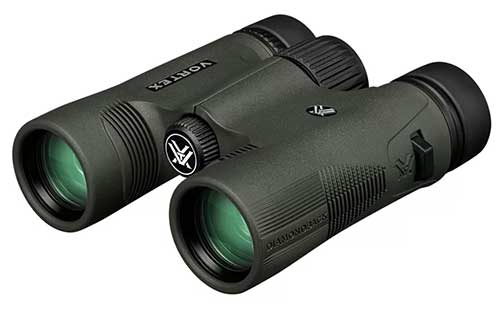
| Estimated Price | $210 |
| Lens | 8×32 |
| Weight | 0.99 lbs, 15.9 oz |
| FOV (Degrees) | 8.19 |
| FOV at 1000 m | 144 m |
| Waterproof Rating | Waterproof, Fog Proof |
Vortex Optics Diamondback binoculars are very popular due to there impressive quality and reasonable price point. The 8×32 is unique cause it weighs less than 1 pound. Most of the time people have the large and heavy 7×50 style binoculars in the mind for marine applications. However when fishing and looking for birds it is typically very sunny and the advantage of having a large objective lens is minimal. Eight times magnification is low enough for a stable image even on a rocking boat.
This same model is also available in 8×28, 8×42, 10×28, 10×32, 10×42, 10×50, 12×50, and 15×56. Any of the 8 times magnification would be good for boating and fishing applications. If you plan to use them in low light conditions the large 42 mm objective lens would likely be the best option.
3. Nikon Monarch M7
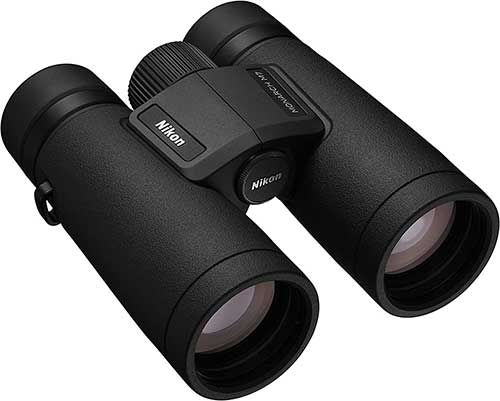
| Estimated Price | $487 |
| Lens | 8×42 |
| Weight | 1.475 lbs, 23.6 oz |
| FOV (Degrees) | 8.3 |
| FOV at 1000 m | 144.4 m |
| Waterproof Rating | Waterproof, Fog Proof |
The Nikon Monarch M7 are high-end waterproof binoculars. These binoculars have 8 times magnification and an objective lens of 42mm. This makes the exit pupil diameter 5.25 mm. For daytime use, a 42mm lens diameter is enough to get full performance with the 8 times magnification level. In low light conditions, a large objective lens would be better but is also heavier. For this reason, I think 8×42 optics are the best for most fishing applications. Binoculars that are 7×50 are widely used on boats but these are significantly large and heavier.
At 1.475 pounds these are light enough to easily carry while hiking and hold for long durations while on a fishing boat. These have a wide field of view of 8 degrees which computes to 128 meters horizontally at 1,000 meters. This is very wide for 8 times magnified binoculars. Other features include the ability to focus as close as 3 meters, a center focus knob, advanced lens coatings, and adjustable eyecups. These are waterproof and fog proof which makes them great for a marine environment. Higher magnification values of 10 and 12 are also available but for use on a boat, 8 power is a better option in most cases.
4. Canon Image Stabilized Waterproof Binoculars
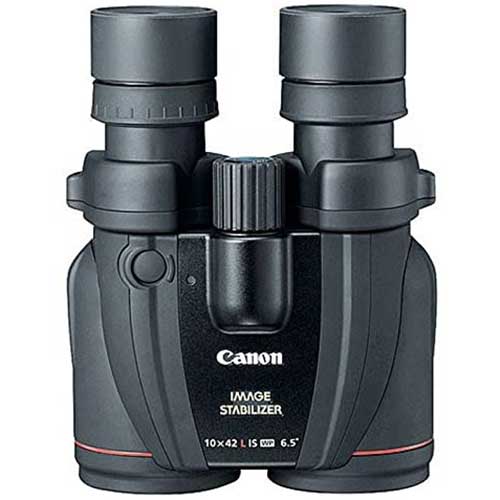
| Estimated Price | $1,440 |
| Lens | 10×42 |
| Weight | 2.44 lbs, 39.15 oz |
| FOV (Degrees) | 6.5 |
| FOV at 1000 m | 114 m |
| Waterproof Rating | Waterproof |
The Canon Image Stabilized waterproof binoculars are a great option for use on boats. Typically it is recommended to get a low 7 or 8 times magnification but since there are image stabiles 10 times magnification will work well. This allows for birds and sea life to be seen at a further distance away. These binoculars can also focus on objects as close as 8.2 feet away. The 42 mm objective lens is great for daytime use and works sufficiently well in low light conditions.
The binoculars are electronic and are powered by 2 AA batteries. These binoculars do work without batteries but are then not image stabilizes. When using a tripod mount having them off is a good way to save batteries. Once activated with the push of a button the binoculars will be on for 5 minutes or until turned off. The angle the image stabilize can correct for is .8 degrees which really helps with shaky hands. Most people that get quality image stabilizes binoculars like these are happy with their performance.
5. Canon Image Stabilized Binoculars III
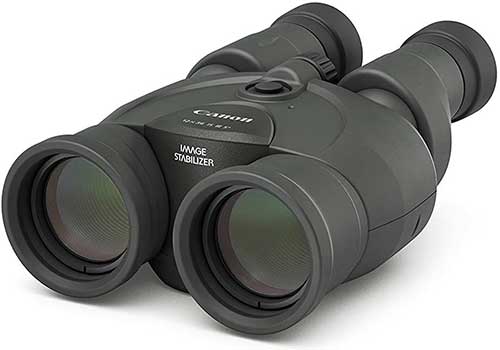
| Estimated Price | $775 |
| Lens | 12×36 |
| Weight | 1.32 lbs, 21.16 oz |
| FOV (Degrees) | 5.0 |
| FOV at 1000 m | 88 m |
| Waterproof Rating | Not waterproof |
Canon Image Stabilized Binoculars III are 12×36 and Canon Image Stabilized Binoculars II are 10×30. This review will be for the 12×36 binoculars but both have very similar features. Neither of these is waterproof so it is important to keep them in a secure dry location. The binoculars are powered with two AA batteries and have an angle of correction of 1 degree.
At just 1.32 pounds these binoculars are light and easy to hold up for long durations. Standard alkaline batters will power the binoculars for about 9 hours when used at room temperature. In cold weather, the battery life will decrease. These binoculars can be used when wearing glasses. Features include Porro II prisms and field flattener lenses for smooth clear edges.
6. Canon 18 x 50 Water Resistant Binoculars
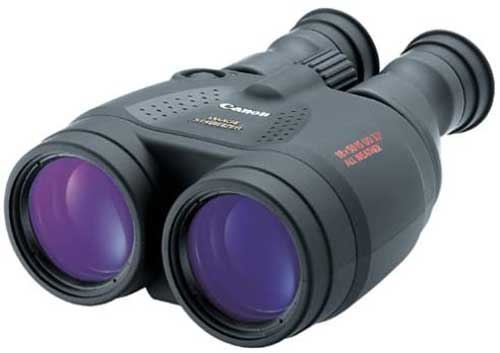
| Estimated Price | $1,900 |
| Lens | 18×50 |
| Weight | 2.60 lbs, 41.06 oz |
| FOV (Degrees) | 3.7 |
| FOV at 1000 m | 65 m |
| Waterproof Rating | JIS 4 Splash Resistant |
Canon 18 x 50 water-resistant and image stabilizes binoculars have a powerful 18 times magnification. These are also available with 15 times magnification. The binoculars are powered with two AA batteries and have a correction angle of .7 degrees. This will help stabilize shaky hands even on an unstable platform like a boat.
The strong magnification will allow more water to be covered while scanning from a single location. However, the field of view is only about half that of 7-time magnification which means it will take more time to scan the area thoroughly. As long as it is not too rough this is a good trade-off. Key features include low dispersion glass, wide 50 mm objective lens, and durable high grip rubber outer layer.
7. Fujinon Image Stabilized Waterproof Binoculars
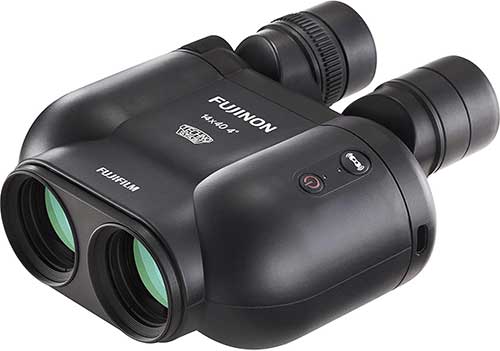
| Estimated Price | $1.300 |
| Lens | 14×40 |
| Weight | 4.2 lbs, 67.2 oz |
| FOV (Degrees) | 4.0 |
| FOV at 1000 m | 70 m |
| Waterproof Rating | Waterproof |
Fujinon image-stabilized waterproof binoculars are water-resistant and buoyant so they float in the water. These are the new version of the popular Fujinon 1440 binoculars. An incredible feature of these binoculars is that they have plus or minus 6 degrees of stabilization. This is more than any other binocular on the market. For boating and fishing in wavy conditions being able to stabilize out and correct hand and boat movements is important.
The binoculars have a 14 times magnification and a 40mm objective lens diameter. This makes the exit pupil diameter 2.85 which is good for daytime conditions. These binoculars are powered with four AAA batteries which will last up to 18 hours with a standard alkaline type. The older model of Fujinon 1440 was waterproof and fog proof. This new model does not say if it is a fog proof design but is made to float so it should be fairly waterproof.
8. Nikon Image Stabilized Marine Binoculars
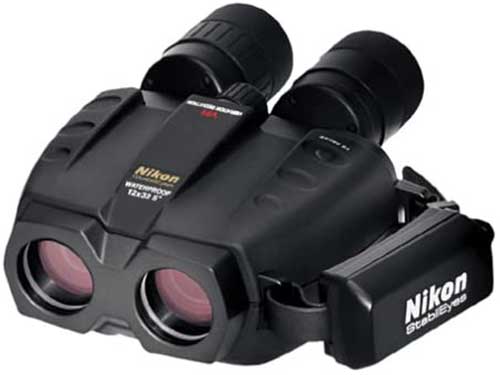
| Estimated Price | $1,200 |
| Lens | 16×32 |
| Weight | 2.5 lbs, 40 oz. |
| FOV (Degrees) | 3.7 |
| FOV at 1000 m | 65 m |
| Waterproof Rating | Waterproof, Fog Proof |
Nikon image stabilized marine binoculars are very popular for use on fishing boats. These have a small 32 mm objective lens which is small for a 16 times magnification lens. This makes the exit pupil diameter 2 mm which is smaller than the pupil even in daylight conditions. During the day the image is still very good but these would now work great in low-light conditions.
The stand out feature of these binoculars is being waterproof and fog proof. Also, these have a high 3 degrees of compensation. This is very high compared to other image stabilizes binoculars. For this reason, they are a good choice to use in wavy offshore conditions where it can be hard to hold hands stable. The binoculars are nitrogen-filled with is not as common in the image stabilized binocular designs.
9. Zeiss Terra ED Waterproof Binoculars
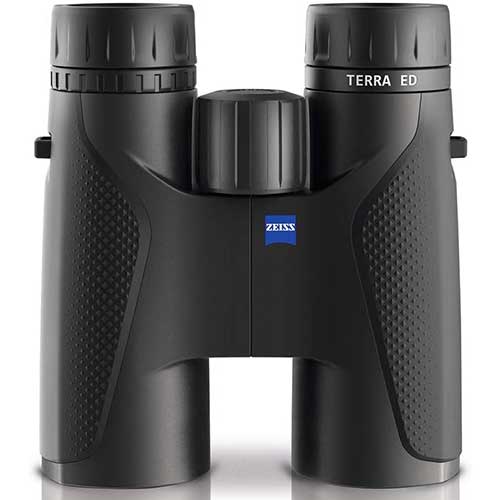
| Estimated Price | $500 |
| Lens | 8×42 |
| Weight | 1.6 lbs, 25.6 oz |
| FOV (Degrees) | 7.1 |
| FOV at 1000 m | 125 m |
| Waterproof Rating | Waterproof |
The Zeiss Terra ED binoculars nitrogen filled, waterproof, and fog proof. This series comes in a variety of sizes including 8×42, 10×42, 8×32, 10×32, 8×25, and 10×25. The 8×42 size weighs 1.6 pounds and is great for boating. This has an exit pupil diameter of 5.25 mm which is good for most lighting conditions.
The 8×25 binoculars aver very compact and weigh just 10.9 ounces. These have an exit pupil diameter of 3.1 mm which is about the human pupil diameter in bright conditions. This means these small light binoculars will actually work about the same as the larger heavier versions on bright sunny days.
Zeiss is known for making binoculars in Germany but the Terra model is made in china. This makes the cost significantly less than other models. The binoculars frame is made of durable fiberglass. Lens caps, neck strap, and zipper case come included with the package.
10. Steiner Commander Submersible Binoculars
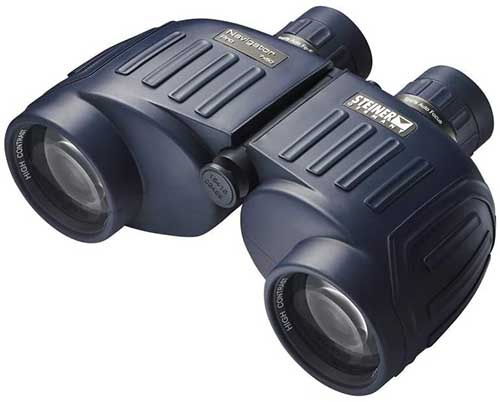
| Estimated Price | $1,278-$1,560 |
| Lens | 7×50 |
| Weight | 2.63 lbs, 42 oz |
| FOV (Degrees) | 8.42 |
| FOV at 1000 m | 148 m |
| Waterproof Rating | Submersible to 33 feet |
The Steiner Commander binoculars are 7 times magnification and have a large 50mm objective lens. Having a 8.42-degree field of view allows for 148 meters of horizontal viewing at a 1,000-meter distance. These are very good specifications for binoculars used for fishing and boating. Also, these have a sealed design that is pressurized with nitrogen making the lenses waterproof and fog proof. This also makes them well suited for a wet marine environment. These quality binoculars are made in Germany.
The binoculars are navy blue and come with or without a compass. These work well in bright and low light conditions due to the 7.14 exit pupil diameter. The binoculars are made with a floating prism design and rubber outer layer which makes them very durable. They are said to be able to handle vibrations and impacts from drops better than most binoculars. The only bad thing about these binoculars is the weight of 2.63 pounds. This is a bit heavy for carrying them long distances when hiking. On a boat, the weight is not important unless they are frequently used for long durations. Overall these are awesome binoculars for fishing, boating, and marine use.
11. Steiner Navigator Marine Binoculars
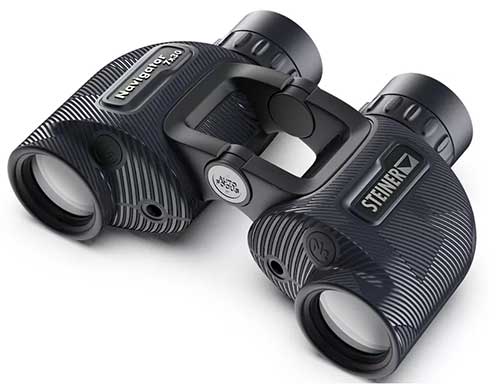
| Estimated Price | $345 |
| Lens | 7×30 |
| Weight | 1.1 lbs, 17.6 oz |
| FOV (Degrees) | 8.05 |
| FOV at 1000 m | 141.2 m |
| Waterproof Rating | Submersible to 16 feet |
Steiner is a known for making quality marine binoculars. The new Steiner Navigators big advantage compared to older models though is its weight at just 1.1 pound. Most older models were over 2 pounds. Having a magnification of 7 and a objective lens diameter of 30 is great for most boating and fishing applications. Another feature not available on most binoculars in this price point is auto-focus. These binoculars have to option to come with or without a built in compass.
The lenses are filled with pressured nitrogen to not allow moisture to fog the lens. Also it allows the optics to be submersible to 16 feet. Lastly the textured outer surface has high grip which allows for stable handling in wet and wavy conditions which is important for fishing binoculars.
12. Leica Ultravid HD Waterproof Binoculars
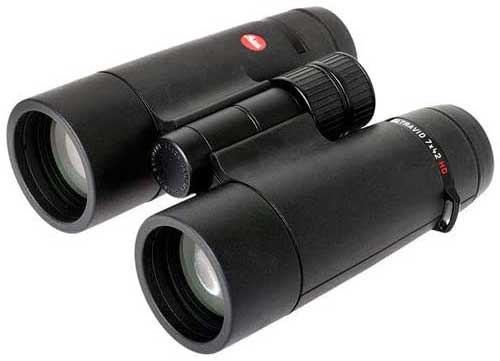
| Estimated Price | $2,300 |
| Lens | 7×42 |
| Weight | 1.7 lbs, 27.16 oz |
| FOV (Degrees) | 8 |
| FOV at 1000 m | 140 m |
| Waterproof Rating | Submersible 16.5 feet |
The Leica 7×42 Ultravid HD Plus binoculars have seven times magnification and a 42mm objective lens. There are many other sizes including 8×32, 8×42, 8×50, 10×32, 10×42, 10×50, and 12×50. The 7×42 is perfect for most boating and fishing applications. These have an exit pupil diameter of 6mm which works great on bright days and is good in low light conditions. These Leica binoculars are made in Portugal.
The lens area is filled with nitrogen which makes the fog proof and submersible to 16.5 feet. Having a wide 8-degree field of view allows the skyline to be quickly scanned for birds, wildlife, or fish activity. The binoculars can focus on something as close as 10.8 feet. A tripod adapter can be purchased separately to fix mount the binoculars. Lens covers, a neoprene neck strap, and a soft case are included with the package. These 7×42 optics are the best for fishing and boating applications.
13. Nikon OceaPro 7×50 Submersible Binoculars
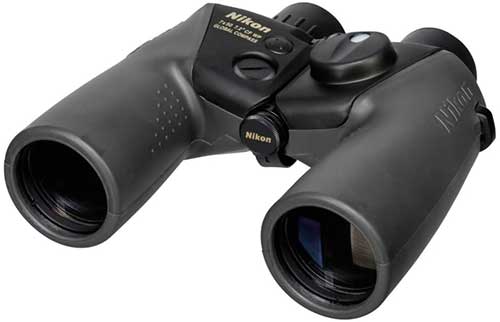
| Estimated Price | $246 – $260 |
| Lens | 7×50 |
| Weight | 2.5 lbs, 40 oz. |
| FOV (Degrees) | 7.2 |
| FOV at 1000 m | 126 m |
| Waterproof Rating | Submersible to 3.2 feet. |
These Nikon OceaPro binoculars are waterproof and fog proof. With a 7 times magnification and 50mm objective lens diameter, these are well suited for low light conditions. A stand out feature of these binoculars is the built-in compass. This helps aid in navigation in a few ways. But knowing the heading to different reference points the boat’s position can be calculated. There is also a scale that helps gauge the size and distance of objects. With modern elections, reference-based navigation using charts is not often used but it is still good to have a system to do so if needed.
The binoculars lenses have specialized coatings to retain light and the Porro prisms are designed to show crisp images. Two LR43 batteries are required to illuminate the compass and need to be purchased separately. A soft carry case is included. These are great binoculars to use on a boat and are specifically designed for marine use.
14. Bushnell H2O Compact Binoculars
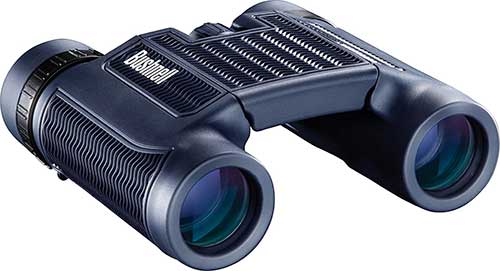
| Estimated Price | $46 |
| Lens | 8×25 |
| Weight | 0.64 lbs, 10.23 oz. |
| FOV (Degrees) | 6.9 |
| FOV at 1000 m | 121 m |
| Waterproof Rating | Waterproof, Fog Proof |
The Bushnell H2O Compact binoculars are a great option for carrying while hiking and boating. These are compact small binoculars that weigh only .64 pounds. The lenses are sealed and filled with nitrogen to make them waterproof and fog proof. These are quality binoculars at a low price point.
The lenses are 8 times magnification with an objective lens diameter of 25 mm. This makes the exit pupil diameter 3.12 mm which works well for daylight conditions. The rubber outer layer provides a comfortable textured grip. These would be the best binoculars for kids and are great for traveling. Their low weight makes it easy to hold them up to the eyes for long durations. A 10×25 size is also available but for use on a rocky boat, the 8 power lenses are a better option.
15. Bushnell H2O Marine Waterproof Binoculars
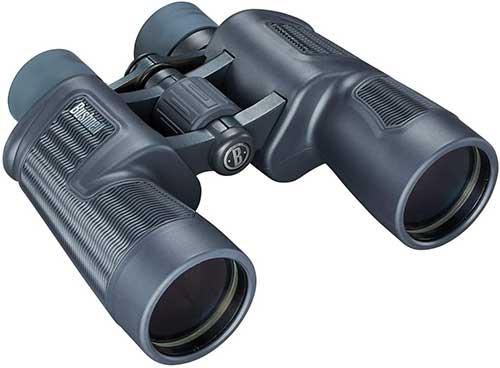
| Estimated Price | $94 |
| Lens | 7×50 |
| Weight | 2.16 lbs, 34.5 oz |
| FOV (Degrees) | 6.7 |
| FOV at 1000 m | 117 m |
| Waterproof Rating | Waterproof, Fog Proof |
The Bushnell marine waterproof binoculars are also fog proof. Similar Bushnell marine binoculars also come with a built-in compass. If you do not plan to use the compass it is probably better to get this version without the compass. The outside color is black. Also included with the package are lens caps, neck strap, and soft velcro lid carry bag.
These binoculars are specifically designed for boating, fishing, and marine applications. The 7 times magnification and 50 mm objective lens is a popular choice for use on the water. Having a 6.7-degree field of view allows lots of water to be scanned quickly. A rubber outer layer keeps the binoculars protected and provides the user with a good grip. Bushnell is known for making quality optics at an affordable price. These binoculars are made in china.
16. Cabela’s Intensity Waterproof Binoculars
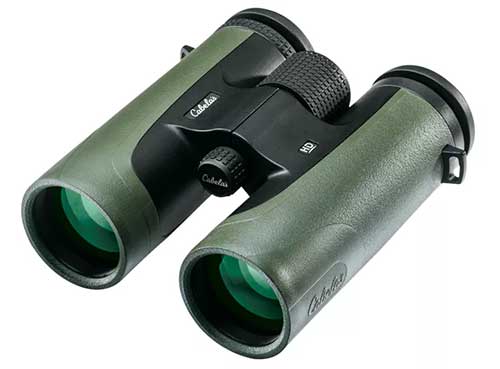
| Estimated Price | $150 |
| 0Lens | 8×42 |
| Weight | 1.63 lbs, 26.1 oz |
| FOV (Degrees) | 8.19 |
| FOV at 1000 m | 144 m |
| Waterproof Rating | IPX7 30 Min, Fog Proof |
Cabela’s Intensity HD binoculars have an IPX7 waterproof rating which means submersible at 1 meter for 30 minutes. This optic is also available in 10×42 and 10×50. For most boating applications it is good stay at 7 or 8 times magnification unless the binoculars are imaged stabilized. The lenses are sealed, have an anti reflective coating, and are made with low-dispersion glass.
Included with the binoculars is a carry case, neck strap, and covers for the front and back lenses. At 1.63 pounds these are average weight for similar binoculars in the 8×42 category. The shell of the binoculars is made with an armor magnesium alloy coated in rubber to make them durable and have a strong grip even in wet conditions.
17. Hooway Waterproof and Floating Marine Binoculars
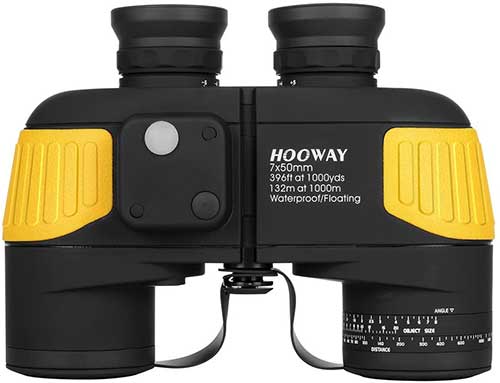
| Estimated Price | $126 |
| Lens | 7×50 |
| Weight | 2.2 lbs, 35.2 oz |
| FOV (Degrees) | 7.5 |
| FOV at 1000 m | 132 m |
| Waterproof Rating | Waterproof, Floating |
The Hooway 7 X 50 binoculars are waterproof, fog proof, and float in the water. This makes them extremely well suited for fishing, boating, and marine applications. The binoculars are 7 times magnification and have 50 mm objective lenses which is great for low light conditions. A compass is built into the optics as is a scale to help to determine distances. Color options are black, black-yellow, and green.
These binoculars have an IPX7 submersible waterproof rating. This means they will not leak when in 1 meter of water for 30 minutes. This is possible by being sealed and filled with nitrogen to be fog proof. These binoculars are large but only weigh 2.2 pounds which is light for binoculars with large 50 mm objective lenses. The rubber outer layer is good for grip and durability. Included with the package are lens caps, a foam neck strap, and a soft carry case. These are great binoculars to keep on a boat or use in a kayak or canoe. Even when hiking the waterproof and fog proof rating allows them to work in rainy conditions.
Waterproof Binoculars Overview
Waterproof Rating
The waterproof rating of binoculars is important. Binoculars are not meant to be used indoors and with outdoor use comes rainy humid days. Also in a marine environment, it is common for gear to get soaking wet from ocean water. The lenses are the most important part to be waterproof. If water gets into the lens it is impossible to clean and can take a long time to find its way out. O-rings are usually used to seal the binoculars. The waterproof rating can be an IPX7 or IPX8 submersible rating. A lesser rating would be water-resistant which should work in light rain but would likely leak if submerged in water.
Fog Proof Rating
Binoculars being fog proof is just as important or more important than being waterproof. Fogproof binoculars are sealed and filled with an inert gas such as nitrogen or argon. This type of gas does not have moister associated with it and will not fog up with changes in temperature. Also since the lenses are sealed water will not get behind the lens and fog up and make the binoculars blurry. The outside lens could still fog or have water on it but this can be cleaned off with a soft dry cloth.
Stabilized Binoculars
Most binoculars that are 7 power and less can be stabilized with human hands. However, when riding in a moving vehicle or boat it can be difficult to stabilize the binoculars. Image stabilized binoculars are good for these conditions and for magnification values higher than 7. This is done by changing the position of the lens based on data received by a gyroscope. All the user has to do is press a button when the binoculars are pointed at the desired object to see.
How to Keep Binoculars Stable
It is important to be able to stabilize binoculars and aim them accurately to be able to clearly see what is being looked at. If you have difficulty holding things stable, getting binoculars that are less magnified will make it easier. The quickest way to use binoculars is to just hold them up with your hands. However, this is the least stable. To make the more stable pulling the elbows against the body helps as does the use of a sling around the neck to provide another anchor point.
Many binoculars have a threaded insert that can be used to mount them to a tripod. This is the most stable way to look through binoculars. If one is not available the user can rest the binoculars on a vehicle, tree, or boat railing. Spotting scopes are another great way to view objects, animals, and birds at a far distance.
Information of Binoculars
Magnification of Binoculars
The obvious reason people use binoculars is to magnify the image so it looks bigger with more detail. Most handheld binoculars have a magnification of 7-15 times what would be seen by the naked eye. The magnification value is printed on most binoculars as the first number in the 7×50, 10×42, or 10×25 value. The 7 and 10 are the magnification values. While it might seem like a higher magnification is better that is not always the case. The stronger the magnification the more difficult it will be to hold the binocular stable and the field of view will decrease. When scanning for birds and animals a wider field of view will allow for more animals to be spotted in most cases. Having a higher magnification will make the animals appear closer.
Objective Lens Diameter of Binoculars
The second number printed on a pair of binoculars is the objective lens diameter. For example, 7×50 binoculars have a 50 mm diameter of the objective lens. The objective lens is the one at the front of the binoculars. Just looking at a pair of binoculars you can tell if there are big or small objective lenses. In the back of a pair of binoculars is the eyepiece which is also called the ocular lens. This is the lens closest to the user’s eye. Looking through the objective lens by itself would cause an inverted image. Prisms within the binoculars are used to make the image appear upright and normal for the user.
The big advantage to large objective lenses around 50 millimeters is that they let in the most light. This allows for crisp images and more bright images in low-light conditions. The disadvantages are that they tend to be heavier and more expensive.
Exit Pupil of Binoculars
Large 50-millimeter objective lenses are considered the best for low light conditions. However, in bright daylight conditions, a large lens is not always needed. This has to do with the exit pupil of the binoculars compared to the size of the pupil in the human eye. The human eye pupil will vary in size from around 3 mm in the day to 7 mm in low light conditions. To calculate the exit pupil the objective lens diameter is divided by the magnification. This means for 7 power binoculars used in bright conditions the objective lens diameter only needs to be 21 mm. The rest of the light gathered will not go into the person’s pupil anyway.
Field of View of Binoculars
The field of view describes how big of an area a user can see when looking through a scope or pair of binoculars. It can be given as an angular field of view usually around 5 to 10 degrees. This angle can then be used to give the horizontal distance, which is basically the diameter of the area that can be seen at 1,000 years away. One degree at 1,000 yards is around 52.5 feet. Often the linear field of view is given as a horizontal distance of 1,000 meters where one degree will be around 57.6 feet.
That is the easiest way to understand the field of view of binoculars and scopes. However, angle measurements can also be given in terms of the apparent field of view or apparent angle of view. This is basically the angular field of view time the magnification of the binoculars. So if 10 times magnification binoculars give the apparent angle of view value of 57.5 degrees the actual angle of view is around 5.75 degrees. Nikon calculates their apparent angle of view slightly differently but for purpose of comparing binoculars, the values are close.
Focus Types of Binoculars
There are two main focus types for most binoculars. These are center focus and individual focus also called fixes focus. Center focus binoculars are the most popular and allow both lenses to be adjusted at the same time. The adjustment allows images to be clear at close or far distances when properly adjusted. Individual focus binoculars allow each lens to be independent. These are set to a value that will work for all viewing beyond around 50 yards but does not work well on close objects. Either type will work well for offshore fishing environments as the objects being looked at are typically very far away.
Lens Quality and Coatings
Having quality lenses in a pair of binoculars allows for a clear image that is brighter in low-light conditions. The coating on the lens can also be important especially anti-reflective coatings. How lenses are secure in the housing is also important. The alignment of the lens and prism is needed to properly focus the binoculars a get a crisp image of the animal, bird, or boat. Being nitrogen-filled and waterproof helps keep the lens from fogging which can make a pair of binoculars useless on wet humid days.
Best Binocular Brands
Canon Binoculars
Canon is well known for making quality optics in campers, video cameras, and binoculars. Their DSLR camera lenses are known to be of the highest quality in the industry. Canon also makes image-stabilized binoculars. This allows for high magnification levels from 10 power to 18 power to be held steady without using a tripod. Some models are waterproof and some are not. These binoculars are popular for boaters and hikers that want powerful handheld binoculars.
Nikon Binoculars
Nikon is another company known for making cameras. The Nikon Monarch series are known to be some of the best waterproof binoculars on the market. These are offered as the Monarch 5 or Monarch 7. Nikon also makes image-stabilized binoculars that have a 16-power magnification. These have a sealed nitrogen-filled lens area which makes them waterproof and fog proof.
Zeiss Binoculars
Zeiss makes quality optics including cameras, microscopes, thermal scopes, and binoculars. The company is known for making the top of line binoculars that are usually quite expensive. The Terra series are popular waterproof binoculars at a moderate price point. Most Zeiss binoculars are made in Germany but the Terra series is made in China.
Swarovski Binoculars
Swarovski Optik makes quality scopes, spotting scopes, and binoculars. The SLC is a waterproof series that is great for marine use. It has magnification levels from 8 to 15 power based on the user’s needs. These are top-quality optics that are made in Austria.
Steiner Binoculars
Steiner makes binoculars for many applications. Their Marine models include the Navigator Pro, Commander, and Marine. All of these are 7 power with 50 mm objective lenses which is considered the best optics for marine application by many people. These are all waterproof and work in low-light conditions. Models with a compass built-in are specifically made for marine and boat navigation. This allows headings and distances to be estimated based on land and buoy information. The binoculars are made in Germany and are known for consistent top-quality performance.
Bushnell Binoculars
Bushnell is known for making binoculars, range finders, and scopes. Their most popular series of binoculars is the Bushnell H20. These are quality and reasonably priced optics. The series has small compact 8×25 lenses for hiking to the larger 7×50 that are popular on sportfishing boats. Bushnell is a United States company but their binoculars are primarily made in China.
Frequently Asked Questions About Binoculars
Which are better 10×50 binoculars vs 10×42 binoculars?
Binoculars that are 10×50 have a better optical performance in low light conditions than 10×42 binoculars. Both are 10 power magnification but the 50 mm objective lens will allow more light to enter. The pupil exit diameter will be 5 mm for the 10×50 and 4.2 mm for the 10×42. In bright conditions when the human pupil is around 3 mm, both will display similar images. In low light conditions when the human pupil is around 7 mm the 50 mm objective lens will collect more light providing a brighter image. The advantage of the smaller 42 mm lens is that the binoculars will likely be significantly lighter. This is a trade-off and the best binoculars will depend on how and under what lighting conditions the binoculars are used.
Are 10×42 binoculars better than 8×42?
For boating operations, 8×42 binoculars are typically better. This is for two reasons. First, the lower 8 times magnification binoculars are easier to hold the image stable on a rocky boat or watercraft. Second, the exit pupil diameter is larger with 8×42 optics providing a brighter image in low-light conditions. Both binoculars will likely be about the same weight and size. If the goal is to see really far in daylight conditions on a stable platform the 10×42 would be better.
How far can 7×50 binoculars see?
Binoculars do not let you see further but allow the image to appear closer. The simple answer is the 7 power lenses will allow images to appear 7 times closer. This also makes it so that small birds that would be too small to see clearly can now be seen. Optics that are 7×50 optics are popular for fishing and boating applications. The large 50 mm objective lens is good for seeing and navigating in low light conditions. If the binoculars are only used on bright sunny days to look for birds a smaller 42 mm or even 25 mm objective lens can be used without a significant difference in performance. However, the binoculars will be much lighter.
How far can 10×25 binoculars see?
Binoculars that are 10×25 can make wildlife and objects appear 10 times closer than they would with the naked eye. The 25 mm objective lenses are quite small for such powerful lenses which will make the image appear less bright. In low light conditions, a larger objective lens diameter would be better. Also, 10 power magnification can be difficult to hand stabilize. For this reason, using a tripod or getting image-stabilized binoculars would be a good idea. Using a tree or ledge to help stabilize the binoculars would also help get a clear image.
What are the best binoculars for long-distance viewing?
Image stabilized binoculars are the best for long-distance viewing. This allows binoculars to be handheld and stable even when using magnification levels up to 18 power. The binoculars are designed to keep the image stable even if the hands a shaky. Once the magnification is 10 power or higher it is a good idea to get image-stabilized binoculars. This is especially true when using them on a boat where it is hard to be rock steady. An alternative to an image-stabilized design would be to mount them on a tripod. The tripod will hold even 18 power binoculars in a way to see images clearly. High-power binoculars should have a large objective lens to allow for a bright image. The field of view will be smaller and that is important to keep in mind when scanning for birds and wildlife at a distance.
Are expensive binoculars worth it?
In most cases, expensive binoculars are worth it, especially for marine use. Quality binoculars have lenses that are sealed and filled with nitrogen or inert gas. This ensures that water will not get into the lenses are create a blurry lens on the inside which can not be cleaned. Getting the proper magnification level and objective lens diameter is also critical to getting the desired performance. Small high-power binoculars do provide the brightest clear image in most cases. If the goal is to see far without a tripod then expensive images stabilized binoculars are a great option. Weight, optics specification, overall quality, and price are all trade-offs the user will have to balance when selecting binoculars.
Which is the best magnification for binoculars?
The best magnification depends on the application. When boating and fishing the platform is not stable and 7 power or 8 power optics are preferred in most cases. If an image-stabilized design is used then up to 18 power can be used. The higher power will make the binoculars have a much more narrow field of view so it will take longer to scan the horizon 360 degrees. When using a tripod higher power is better in most cases. The downside in low light conditions is the image may appear dark unless a large objective lens is used. Higher power magnification binoculars do not necessarily mean heavier. However, if they are used in low light conditions the exit pupil diameter should be at least 6 mm. This requires larger objective lenses which do increase the weight.
What are the best binoculars for marine use and fishing?
The best binoculars for fishing have 7 times or 8 times magnification. This allows for the binoculars to be held steady enough to see clearly in wavy conditions. Image stabilized binoculars are also great and allow for a higher power to be used. Fishing and marine binoculars should defiantly be waterproof and fog proof as there is a high chance they will get wet at some point.
Binoculars used for marine navigation should have a compass and scale. This allows for the direction of landmarks and buoys to be charted to determine the boat’s positions. Binoculars with 7×50 optics have a large 7.1 mm exit pupil diameter which is great for low light conditions. This is important to see obstacles and navigation buoys from a distance at dusk and at night. Night vision binoculars and thermal scopes are also becoming popular to assist with boating navigation.
What strength binoculars do I need?
The best strength of binoculars depends on the application. A mistake many people make is that they think higher magnification lenses mean better binocular performance. Higher power binoculars are harder to hold steady, have a more narrow field of view, and require a large objective lens diameter for good low light performance. This means good high-power binoculars are going to be heavy. Unless a tripod is used or the binoculars are image stabilized getting 10 power or less is a good idea. Often it is desirable for the binoculars to be lightweight and lower power optics will be brighter for the same objective lens diameter. For this reason, I find that 8 power binoculars with a 42mm objective lens provide the best overall balance of all performance parameters.
Captain Cody has worked on charter fishing boats in the Florida Keys, Virgin Islands, and Alaska. Growing up in Pennsylvania Cody has also done extensive freshwater fishing including bass fishing tournaments. Cody strives to provide detailed information about the best fishing gear and tactics to help both novice and experienced anglers have a more productive and enjoyable time on the water. Cody also has a background in aerospace engineering and neuroscience but really only takes pride in being good at one thing and that is fishing!
